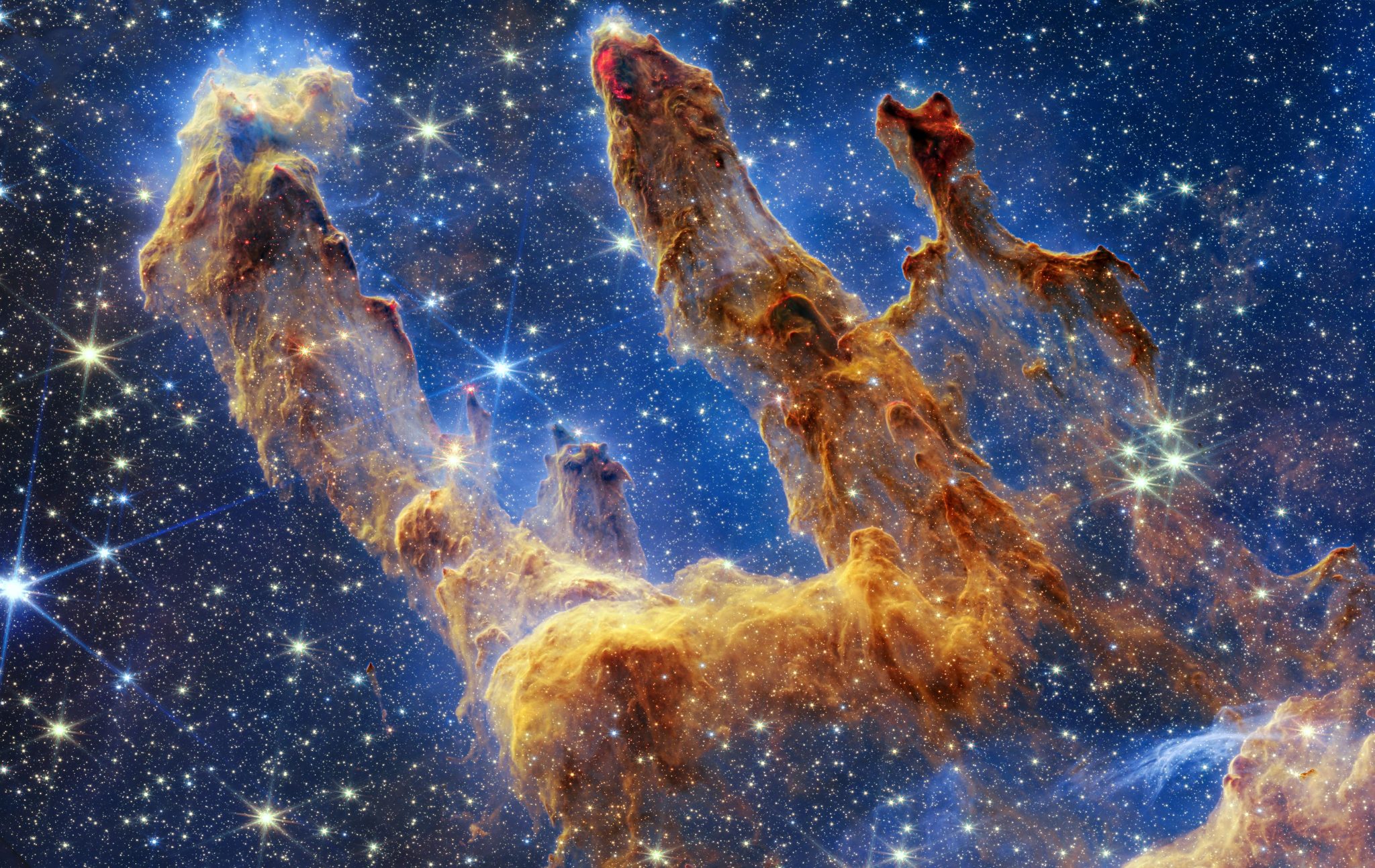El Telescopio Espacial Webb captura un increíble retrato lleno de estrellas de los Pilares de la Creación
1 min read
La luz del infrarrojo cercano revela vastas poblaciones de estrellas en formación, muchas aún atrapadas en el polvo
James Webb Space Telescope’s Near-Infrared Camera captured this glittering view of the Pillars of Creation – and it begs to be examined pixel by pixel. It is a stunning scene that may look both familiar and entirely new at the same time. It was first captured by NASA’s Hubble Space Telescope in 1995 and followed up in 2014, and many other telescopes have deeply gazed at this scene. However, this is the first time an observatory has delivered such detailed data in near-infrared light. Newly formed stars pop out in shades of pink, red, and crimson. Still-forming stars that remain hidden deep in dusty pillars resemble molten lava, and fully-formed blue and yellow stars sprinkle the scene.
Where are the galaxies that often “photobomb” Webb’s images? The pillars are located directly in front of our Milky Way galaxy’s disk, which blocks our view of the galaxies that lie behind it. It is also lit up by the collective light from the packed “party” of stars. With these new data, researchers will be able to update complex models of star formation with even more precise star counts and dust quantities. It is clear that we are about to learn a whole lot more about how stars form.

The Pillars of Creation are set off in a kaleidoscope of color in NASA’s James Webb Space Telescope’s near-infrared-light view. The pillars look like arches and spires rising out of a desert landscape, but are filled with semi-transparent gas and dust, and ever-changing. This is a region where young stars are forming – or have barely burst from their dusty cocoons as they continue to form. Credit: NASA, ESA, CSA, STScI; Joseph DePasquale (STScI), Anton M. Koekemoer (STScI), Alyssa Pagan (STScI).
NASA’s Webb Takes Star-Filled Portrait of Pillars of Creation
In exquisite detail, NASA’s James Webb Space Telescope has captured a lush, intricate landscape – the iconic Pillars of Creation. This is a region where new stars are forming within dense clouds of gas and dust. The three-dimensional pillars resemble majestic rock formations, but are far more permeable. These columns are made up of cool interstellar gas and dust that appear – at times – semi-transparent in near-infrared light.
Webb’s new view of the Pillars of Creation, which were first made famous when imaged by NASA’s Hubble Space Telescope in 1995, will help astronomers revamp their models of star formation by identifying far more precise counts of newly formed stars, along with the quantities of gas and dust in the region. Over time, they will begin to build a clearer understanding of how stars form and burst out of these dusty clouds over millions of years.

NASA’s Hubble Space Telescope made the Pillars of Creation famous with its first image in 1995, but revisited the scene in 2014 to reveal a sharper, wider view in visible light, shown above at left. A new, near-infrared-light view from NASA’s James Webb Space Telescope, at right, helps us peer through more of the dust in this star-forming region. The thick, dusty brown pillars are no longer as opaque and many more red stars that are still forming come into view. Credit: NASA, ESA, CSA, STScI; Joseph DePasquale (STScI), Anton M. Koekemoer (STScI), Alyssa Pagan (STScI).
Newly formed stars are the scene-stealers in this stunning image from Webb’s Near-Infrared Camera (NIRCam). These are the bright red orbs that typically have diffraction spikes and lie outside one of the dusty pillars. When knots with sufficient mass form within the pillars of gas and dust, they begin to collapse under their own gravity, slowly heat up, and eventually form new stars.
What about those wavy lines that look like lava at the edges of some pillars? These are ejections from stars that are still forming within the gas and dust. Young stars periodically shoot out supersonic jets that collide with clouds of material, like these thick pillars. This sometimes also results in bow shocks, which can form wavy patterns like a boat does as it moves through water. The crimson glow comes from the energetic hydrogen molecules that result from jets and shocks. This is evident in the second and third pillars from the top – the NIRCam image is practically pulsing with their activity. These young stars are estimated to be only a few hundred thousand years old.
Realice un recorrido en video de la vista de infrarrojo cercano de Webb de los Pilares de la Creación. Créditos: NASA, ESA, ASC, STScI; Joseph DePasquale (STScI), Anton M. Koekemoer (STScI), Alyssa Pagan (STScI); Danielle Kirshenblat (STScI).
Aunque podría parecer que la luz del infrarrojo cercano permitió a Webb “atravesar” las nubes para revelar vastas distancias cósmicas más allá de los pilares, no hay galaxias en esta vista. En cambio, una mezcla de gas translúcido y polvo conocido como el medio interestelar en la parte más densa del disco de nuestra galaxia, la Vía Láctea, bloquea nuestra visión del universo más profundo. (El medio interestelar es el gas y el polvo dispersos entre las estrellas de una galaxia. Está compuesto principalmente por átomos de hidrógeno, moléculas y partículas sólidas de polvo).
Esta escena fue fotografiada por primera vez por Hubble en 1995 y revisado en 2014, pero muchos otros observatorios también han estado observando esta región con atención. Cada instrumento avanzado ofrece a los investigadores nuevos detalles sobre esta región que está virtualmente repleta de estrellas.
Esta imagen muy recortada se encuentra en la vasta Nebulosa del Águila, que se encuentra a 6.500 años luz de distancia.
los Telescopio espacial James Webb es el el telescopio espacial más potente jamás construido y el primer observatorio de ciencia espacial del mundo. Será resolver misterios en nuestro sistema solar, mira más allá para mundos distantes alrededor de otras estrellasy sondear las misteriosas estructuras y orígenes de nuestro universo y nuestro lugar en él. Webb es un programa internacional dirigido por NASA con sus socios, ESA (Agencia Espacial Europea) y CSA (Agencia Espacial Canadiense).

“Increíble aficionado a la música. Estudiante. Empollón empedernido del café. Jugador. Especialista web aficionado. Pionero malvado de la cultura pop”.


